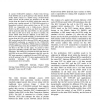Free Online Productivity Tools
i2Speak
i2Symbol
i2OCR
iTex2Img
iWeb2Print
iWeb2Shot
i2Type
iPdf2Split
iPdf2Merge
i2Bopomofo
i2Arabic
i2Style
i2Image
i2PDF
iLatex2Rtf
Sci2ools
MOBIQUITOUS
2005
IEEE
2005
IEEE
PPP Migration: A Technique for Low-Latency Handoff in CDMA2000 Networks
In current CDMA2000 standard, a Packet Data Serving Node (PDSN) acts as an IP gateway to the Internet. Mobile Nodes (MN) connect to a PDSN using a Point-to-Point (PPP) session and IP packets are tunneled over the PPP session from the client to the PDSN which then routes the packets onto a packet network. A CDMA2000 network is a hierarchical network where packets from an MN to the PDSN are transported over a Radio-Access Network (RAN). An MN could move from one RAN to another and still be anchored under the same PDSN; it is also possible that when an MN moves from one RAN to another, the anchor PDSN itself becomes different. In the latter case, there are two ways to handle mobility: (i) tear down the PPP session from the MN to the old PDSN and establish a new PPP session from the MN to the new PDSN, and (ii) use the fast-handoff mechanism as specified in the CDMA2000 standard where a P-P (PDSN to PDSN) tunnel is established to tunnel PPP frames from the old PDSN to the new PDSN and the...
| Added | 25 Jun 2010 |
| Updated | 25 Jun 2010 |
| Type | Conference |
| Year | 2005 |
| Where | MOBIQUITOUS |
| Authors | Anand Kagalkar, Sarit Mukherjee, Sampath Rangarajan, Katherine Guo |
Comments (0)

